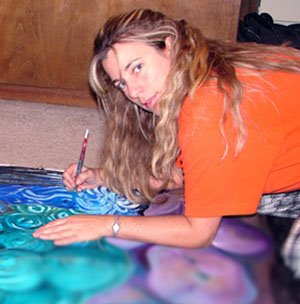
Speaking of anachronisms, Morse Clary continues to use the book form as a "sculptural metaphor," as he describes it. Building on the premise of an open book, Clary articulates richly layered ideas that "read" as story, concept, emotion, setting.
They're both visual and verbal, with titles like Dialogue in Contrast (above) and Crossroads (below). They feel familiar, yet also rarified, old, sometimes appearing like an artifact of a forgotten language.
Clary, a college art instructor for 30+ years, engages the viewer, giving just enough information for us to want to reach out and learn more. His exhibition of "Journeys and Journals" continues through December 11 at NIC's Boswell Hall Gallery.
I love irony. It's one of the most basic yet versatile tools an artist has. James Green works in stone lithography, a printing method founded upon our earliest awareness of stone carving and image making. In his recent works, including an exhibition entitled In Defense of Thingness at Eastern Washington University, Greene explores the paradoxical state of image making.
From his statement: "What are we to make of a culture that considers digital books to have an infinite lifespan but considers stone tablets obsolete? If anything, stone tablets have more than proved themselves capable of survival into the future, while my digital photo files of only 5 years ago are a challenge to maintain and retrieve without some kind of digital corruption or data loss. For this exhibition, I consider our current technological moment while working with my hands to produce objects that stand out specifically because they are obsolete. I have grained and leveled 12 long-forgotten lithography stones (once used for commercial printing) in order to reinvigorate the value of satisfying craftwork and careful execution needed to perform this obsolete technological process. The objects depicted are things I either own or regularly use to perform tasks. All of them have been outstripped technologically, but all of them represent things that have proven successful at surviving into the future. These objects reflect a humanness and concreteness that is bound specifically to the interest they hold as things.
He also works in photography, prints and installations. I won't get to his show at EWU before it closes December 10, which is too bad because I was just talking with one of my editors about the lack of exhibitions showcasing truly contemporary art. And here's one of them (that won't get covered locally, unfortunately).
While it's not the kind of work I can immerse myself in the way I like to with narrative art, I appreciate the conceptual depth and challenge. It's this chicken/egg approach of the thing versus the image of the thing versus the making of the image versus the potency of the thing within our visual lexicon. The image above, for example, is a blower used for making fire. As Greene mentions, this is an object that has remained fairly unchanged over time. Not many objects can be regarded as such; there's such a bent to revise, improve, technologize.
For more mindblowing, check out his website at Valuistics.com.

Envy is not a pretty thing but I'll admit to it when it comes to Mary Maxam. At first, I envied her poise and patience when it came to teaching. When I met her 9-10 years ago, she ws the senior member of the visual arts faculty in Lakeland School District (the visual arts faculty consisting of her, myself and two junior high teachers).
Then, when I had opportunities to visit with Mary during rare unstructured collaboration days, I had all the more reason to envy her exceptional painting skills. Like this humble little painting of a reflective gift box shows, Mary Maxam knows paint. And color. And light.
With her specialties including fly fisherman, landscapes and the occasional still life, Mary shares her artful gifts via a self-titled website on which she has recently added "daily paintings."
Ok, so now I envy her one more thing: retirement (and time to paint).

She's been abroad for a bit, charcoal in hand and a keen eye for the delicious curves that populate her often haunting charcoal drawings. A field in Provence, France. The ridiculous curled lip of a sneering gargoyle. A shaft of light at the distant edge of an overgrown lake. These are the images that come into view from her painstaking process of charcoal drawing.
A long ways away from her beloved Palouse, Nelson nonetheless expresses elements of these foreign vistas as if they were a second home, fraught with all the mystery and moodiness that her earlier eastern Washington landscapes possessed.
At The Art Spirit until November 28.

